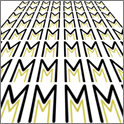New devices based on Metamaterials

Metamaterials could be considered as being the latest revolution within the Electrical and Electronic Engineering community. Indeed, the interest in Metamaterials has given rise to the creation of Metamorphose, a European consortium focusing on the scientific research of these new artificial materials. The control over the material properties is traditionally achieved by the chemical combination of different compounds in such a way that a different substance is obtained. Stainless steel, teflon or kevlar among many others materials are clear success stories of this procedure. However, if a new material is obtained by a structural combination of different compounds, the resulting structure has its own properties and when considered as a whole, receives the name of composite [1]. The composite materials play nowadays an important role in the different subsystems of a spacecraft. For instance ceramic matrix composites can be found in airframes and propulsion components.
When the composite exhibits new properties in response to an external electromagnetic field, it is referred to as an electromagnetic composite or as a Metamaterial [2]. The properties that Metamaterials are able to show can be as spectacular as: negative permeability and permittivity [3] or an electromagnetic band gap [4]. For a detailed classification of Metamaterials see Ref. [2].
Space applications of Metamaterial devices
The particular properties that characterize Metamaterials have enabled the appearance of new concept devices, e.g. electromagnetic band gap [4], perfect lenses [6] and invisibility devices [5][7]. These concepts seem to have potential to play a disruptive role in the development of new devices to be used in space missions: Examples could be in the fields of the design of antennas and waveguides [8], or a photonic bandgap substrate to enhance the performance of a patch-antenna [9].
As further application, the possibility to manipulate electromagnetic fields opens a new way to design lens concepts which are able to expel or concentrate the radiation in a certain space region. The invisibility cloak could have a potential as a thermal isolator. In free space the only mechanism of heat transfer is radiation. Hence, a body inside of the cloaked region became invisible to the incoming radiation and therefore its absorption could be considered negligible. Additionally, an invisibility cloak can reduce the pressure exerted by the solar radiation on an spacecraft, influencing its orbital stability as a result of the particular way in which electromagnetic radiation is scattered by the cloak.
While reliable inverse design strategies are mandatory for any systematic application of Metamaterials, this task becomes much more important and more complicated in space applications. Besides functional specifications essentially defined through the intended purpose of the material, any space application will face numerous additional constraints, such as weight of the device, materials that can be used, robustness and lifetime or workability under extreme conditions. These constraints will reduce the "search space" for Metamaterials with a certain characteristic, which therefore increases the need for sophisticated but reliable inverse engineering methods. At the same time generic inverse design strategies (i.e. strategies not confined to certain applications, realizations or materials) can help to explore all possibilities within the given constraints and therefore offer much more flexibility than design methods restricted to certain situations.
Related ACT activities
There are many research areas in which metamaterials could provide a technological improvement. Given the impossibility to contribute to all of them, the ACT decided to focus on design strategies for the development of devices operating at visible frequencies.
Most of the activities have been carried out in collaboration with four European Universities within the Ariadna programme: Helsinki University of Technology (TKK), Royal Institute of Technology (KTH, Stockholm), University Roma Tre and IEMN (University of Lille).
References
- K. K. Chawla, Composite Materials: Science and Engineering, Springer (1998)
- A. Sihvola, Metamaterials in electromagnetics, Metamaterials 1, 2 (2007) [link]
- D. R. Smith, W. J. Padilla, D. C. Vier, S. C. Nemat-Nasser and S. Schultz, Composite medium with simultaneously negative permeability and permittivity, Phys. Rev. Lett. 84, 4184 (2000) [link]
- M. Notomi, Theory of light propagation in strongly modulated photonic crystals: refranctionlike behavior in the vicinity of the photonic band gap, Phys. Rev. B 62, 10696 (2000) [link]
- J. B. Pendry, D. Shurig, and D. R. Smith, Controlling electromagnetic fields, Science 312, 1780 (2006) [link]
- J. B. Pendry, Negative refraction makes a perfect lens, Phys. Rev. Lett. 85, 3966 (2000) [link]
- U. Leonhardt, Optical conformal mapping, Science 312, 1777 (2006) [link]
- N. Engheta and R. W. Ziolkowski, Metamaterials: Physics and Engineering Explorations, Wiley-IEEE Press (2006)
- R. Gonzalo, P. de Maagt, and M. Sorolla, Enhanced patch-antenna performance by suppressing surface waves using photonic-bandgap substrates, IEEE Transactions on MTT 47, 2131 (1999) [link]